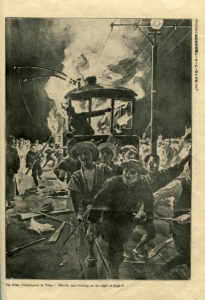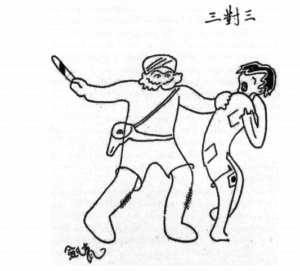Yuanmingyuan, or the Old Summer Palace in Beijing, fits into Manish Chalana’s idea of a spacial palimpsest, similar to Sanam Luang Park in Bangkok.[1] When considering the history of these spaces, one can almost feel as if they are looking at fossil layers in the earth. Sanam Luang was at first a regal space, reserved for royal ceremonies and cremations. In the 20th century it became a contested political space where students staged protests against Thailand’s military junta governments and now it is a space for Bangkok’s well-known vices such as prostitution. Yuanmingyuan has a similarly turbulent history. Each layer of Yuanmingyuan’s history is imbued with the political, social and economic upheaval China has experienced over the past 150 years.
Yuanmingyuan was the primary retreat for Qing emperors who found the Forbidden City and urban landscape of Beijing to be stifling. In contrast to the cacophony of inner Beijing and the austere but imposing Forbidden city, Yuanmingyuan was supposedly a place of great natural beauty. The retreat was designed to resemble the Jiangnan region, a southern area where famous Chinese painters and poets came from.[2] It’s gardens and man-made lakes were said to have made Yuanmingyuan into an oasis and a paradise on the outskirts of Beijing. The Qianlong emperor included a European-style section to the palace gardens, drawing on the recommendations of his Jesuit advisors. British and French forces, having established a military presence in northern China as a result of the Second Opium War, came to blows with Chinese Imperial forces and marched into Beijing after the emperor had already fled the city. A British legation, led by Harry Parkes, was killed by Imperial troops during the conflict.[3] Anglo-French troops responded by razing and looting Yuangmingyuan, dealing a personal and symbolic blow to the emperor, who had grown up on the summer palace grounds.
Today, the Yuanmingyuan park is a paradoxical space. It represents the scars left by foreign exploitation, but it is also represents the renewal and resurgence of China. It is both a “gradenscape” and “ruinscape.”[4] Visitors to the park witness the broken marble columns where the French and British troops laid waste to the palace and looted its most valuable art. On the other hand, they are also able to enjoy the beautiful recreational landscape Yuanmingyuan has become. As Haiyan Lee articulates, “the pain of loss and humiliation is always acknowledged, but pleasure is never far from consideration.” [5] Significant investment from the government has helped to renovate the area and turn it into a family-oriented recreational park, similar to Western-style botanic gardens. Yet it is also still a memorial, a place whose main intention is to immortalise history. Yuanmingyuan’s history carries a significant amount of weight. The ruins are a reminder of the decadence of the Emperor and the injustice China endured in the face of colonial powers. More than anything, the space symbolises the ways in which China has changed and how it has decided to memorialise its troubled and violent past. Yuanmingyuan is no longer just an enclave reserved for imperial corruption and decadence, nor is it blatant evidence of China’s weakness and foreign incursion. Rather it is a space for the public to engage in memorialisation of Yuanmingyuan’s collective past and enjoy it as a place for recreation and well-being.
[1] Noobanjong, Koompong. “The Royal Field (Sanam Luang): Bangkok’s Polysemic Urban Palimpsest.” In Messy Urbanism: Understanding the “Other” Cities of Asia, edited by Manish Chalana. Hong Kong University Press, 2016.
[2] Li, Lillian. “The Garden of Perfect Brightness.” Visualising Cultures. Massachusetts Institute of Technology. (2012). https://visualizingcultures.mit.edu/garden_perfect_brightness_03/index.html
[3] Ibid
[4] Lee, Haiyan. “The Ruins of Yuanmingyuan: Or, How to Enjoy a National Wound.” Modern China 35, no. 2 (2009): 155-90. www.jstor.org/stable/27746912.
[5] Ibid

